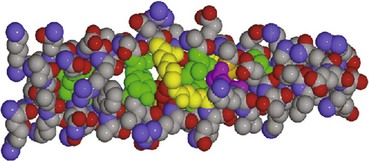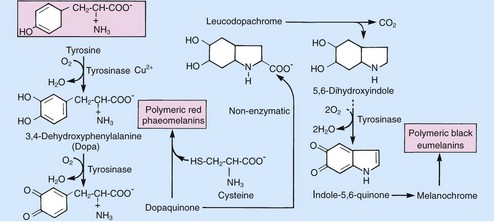Biochemistry of the skin
Keratins
Keratins are high-molecular-weight polypeptide chains produced by keratinocytes (Fig. 1). They are the major constituent of the stratum corneum, hair and nails. The stratum corneum comprises 65% keratin (along with 10% soluble protein, 10% amino acid, 10% lipid and 5% cell membrane).

Fig. 1 Molecular structure of alpha-keratin.
From J Invest Dermatol 2001: 116; 964–969, with permission of Blackwell Publishing.
Melanins
Melanin is produced from tyrosine (Fig. 2) in melanocytes and takes two forms:
 eumelanin, which is more common and gives a brown–black colour
eumelanin, which is more common and gives a brown–black colour
 phaeomelanin, which is less common and produces a yellow or red colour.
phaeomelanin, which is less common and produces a yellow or red colour.
Collagens
Collagens are synthesized by fibroblasts (Fig. 3) and are the major structural proteins of the dermis, forming 70–80% of its dry weight. The main amino acids in collagens are glycine, proline and hydroxyproline. Collagens are broken down, e.g. in wound healing, by collagenases, of which the matrix metalloproteinases are important. There are over 22 types of collagen; at least five are found in skin:








